

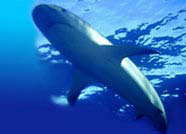
Shark Glossary

 |
 |
 |
|||
| Home | Evolution
| Classification
| Glossary | Biology
| Behavior | Shark
Repellent | Shark
Conservation | Do's &
Don'ts | Did You Know?
Shark Glossary |
 |
||||
|
 Calf
Shark Calf
SharkThe calf shark (also known as the Bigeye sixgill shark and the Lesser sixgill shark) lives in warm temperate seas, usually living on the bottom. It averages about 6 feet (1.8m) long. The skin ranges from dark gray to light gray. Classification: Order Hexanchiformes (frilled and cowsharks), Family Hexanchidae (cowsharks, sixgilled and sevengilled sharks), Genus and species Hexanchus vitalus (Springer and Waller, 1969) or Hexanchus nakamurai (Teng, 1962) - the latter is preferred. Carcharhinidae Family Carcharhinidae (also known as requiem sharks) are a type of large Carcharhiniformes sharks. with 5 gill slits, two dorsal fins, an anal fin, no fin spines, the mouth behind the eyes, and nictitating eyelids. There are 48 species of carcharinidae including the tiger shark, Dusky shark, Bull shark, Galapagos shark, Sandbar shark, and many others. Carcharhiniformes A clade of sharks with 5 gill slits, two dorsal fins, an anal fin, no fin spines, the mouth behind the eyes, and nictitating eyelids. These include the ground sharks: catsharks, swellsharks, shysharks, houndsharks, weasel sharks, requiem and hammerhead sharks. Carcharodon (or Carcharocles) Megalodon Carcharodon (or Carcharocles) megalodon was an ancient shark, living between 5-1.6 million years ago; it is extinct. It may have been up to 40 feet (12 m) long and had teeth up to 6.5 inches (17 cm) long. Carnivore Carnivores are animals that eat meat. They usually have sharp teeth and powerful jaws.  Carpet
Sharks Carpet
SharksClade of shark that has an anal fin, 5 gill slits, 2 dorsal fins (about the same size), no fin spines, and the mouth in front of the eyes. The carpet sharks include: epaulette sharks, the wobbegong, nurse, bamboosharks, blind, zebra, and whale sharks. Most carpet sharks are small and have thin, slightly flat bodies. They are mainly nocturnal (most active at night) and generally eat small bottom-dwelling fish. Carribean Reef Shark The Carribean Reef Shark (Carcharhinus perezi) is a large, common shark found in warm water reefs of the Western Atlantic Ocean (from Florida, USA to Bermuda to southern Brazil). This shark has a stout body with gray to gray-brown skin above (with lighter skin below). It has a rounded snout, long pectoral fins, and a dorsal fin with a sharp point. The long, serrated teeth have broad bases, and are able to eat fish, rays, and cephalopods. This fast swimmer grows to be about 10 ft ( m) long. These sharks have attacked divers on occasion. Females give birth to 4 to 6 pups in each litter. This shark is harvested for its oil, meat, skin, and for fishmeal. Carrion Carrion is the dead flesh of an animal. Many sharks, including the great white shark, eat carrion found floating the seas. Cartilage Sharks' skeletons are made out of cartilage, not bone. People's ears and bones are made of cartilage.There is cartilage around the joints of animals with bony skeletons. 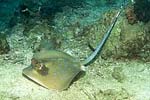 Cartilaginous
Fish Cartilaginous
FishThe cartilaginous fish (Chondrichthyes), are fish whose skeletons are made up of cartilage, not bone. They include the sharks, rays, skates, ratfish, and others. Catsharks Catsharks are a family of small sharks (family Scyliorhinidae, order Carcharhiniformes) that live in cold, deep water, have slit-like pupils, and are primarily night feeders. These ground sharks have an anal fin, 5 gill slits, 2 dorsal fins, no fin spines, the mouth located behind the eyes, and nictitating eyelids. They are oviparous and have purse-shaped eggs with long tendrils that anchor the egg to the ocean floor. Catsharks live in temperate waters and are frequently found along the bottom of tropical reefs poking around crevices looking for food (benthic fish and invertebrates). There are 89 different species of cat sharks, including the coral catshark, the striped catshark, and the Smallspotted catshark. Chondryichthyes Chondryichthyes are cartilaginous fish, including the sharks, skates, and rays. They lack true bone and have skeletons composed of cartilage. Because of this they do not fossilize well.  Cigar
Shark Cigar
SharkThe cigar shark (Isistius brasiliensis) is a small, large-eyed predator that lives in deep tropical ocean waters worldwide. The cigar shark is also known as the cookiecutter shark (due to its color and shape), the luminous shark (because it emits a green glow from its belly), and the Brazilian shark. This brown shark grows to be almost 2 ft (50 cm) long and has a blunt snout. The dorsal fin is small and closer to its tail than on most sharks. The large eyes have green pupils. It is harmless to humans and is rarely even seen by divers. It eats by taking cookiecutter-shaped bites out of its victims with its long teeth and powerful jaws, mostly attacking large fish and whales (including dolphins). In an attack, the cookiecutter shark attaches to its victim with its lips like a suction cup (it created a vacuum). It then uses saw-like teeth that swivel and take an oval-shaped bite of flesh. The belly of the cookiecutter shark has a small patch of bioluminescence on it. This patch is thought to lure fish to it in the dark, deep ocean environment. Hungry fish think the cookiecutter is a smaller fish than it is (because the patch is smaller than the cookiecutter and that is all they can see in the dark); the cookiecutter can then ambush and bite the surprised "hunter." The cookiecutter reproduces via aplacental viviparity, but little else is known about its reproduction. Cladoselache The earliest complete fossil shark was from this genus, which lived from the mid-Devonian through the Permian periods. They had 3-pointed teeth, each having a large central point and smaller cusps flanking it. These sharks were about 1.5-6 feet (0.5-2 m) long and had large spines in front of each of the 2 dorsal fins. They had neither an anal fin nor claspers. 5 gill slits were on each side of the head. Fossil have been found in the Cleveland shales including fossilized stomach contents which reveal that they ate fish. 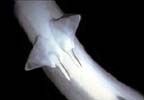 Claspers ClaspersClaspers are modified organs that enable the two sexes to clasp to one another during mating. Male sharks have claspers. Cold Blooded Cold blooded (or ectothermic) animals rely upon the temperature and their behavior (like sunning themselves) to regulate their body temperature. Many reptiles are ectothermic. Most sharks are cold-blooded, only a few, like the Mako and the Great white shark can raise their temperature above that of the water. Commensalism Commensalism is a situation in which two organisms are associated in a relationship in which one benefits from the relationship and the other is not affected much. The two animals are called commensals. The shark and the pilot fish (and remora) are commensals - the pilot fish benefits much more than the shark. Commensalism is a type of symbiosis.  Common
Thresher Shark Common
Thresher SharkAlopias vulpinus is a Lamniformes (or mackerel shark) whose tail fin has a greatly elongated upper lobe. It grows to be about 16.5 to 20 feet (5 to 6 m) long with a countershaded body, blue above, white underneath. It has small jaws, but can use its tail to corral and even kill fish. Like other mackerel sharks, it has an anal fin, 5 gill slits, 2 dorsal fins, no fin spines, mouth behind the eyes, and no nictitating eyelids. It is a very strong swimmer and can even leap out of the water. It swims from the surface to a depth of about 1,150 feet (350 m). Mature females (at least 10 feet (3 m) long have litters of 4 to 6 pups, bearing live young. It lives in tropical and temperate waters, including the eastern and western Atlantic, the central Pacific, and the Indo-west pacific. 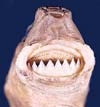 Cookiecutter
Shark Cookiecutter
SharkThe cookiecutter shark (Isistius brasiliensis) is a small, large-eyed predator that lives in deep tropical ocean waters worldwide. The cookiecutter is also known as the cigar shark (due to its color and shape), the luminous shark (because it emits a green glow from its belly), and the Brazilian shark. This brown shark grows to be almost 2 ft (50 cm) long and has a blunt snout. The dorsal fin is small and closer to its tail than on most sharks. The large eyes have green pupils. It is harmless to humans and is rarely even seen by divers. It eats by taking cookiecutter-shaped bites out of its victims with its long teeth and powerful jaws, mostly attacking large fish and whales (including dolphins). In an attack, the cookiecutter shark attaches to its victim with its lips like a suction cup (it created a vacuum). It then uses saw-like teeth that swivel and take an oval-shaped bite of flesh. The belly of the cookiecutter shark has a small patch of bioluminescence on it. This patch is thought to lure fish to it in the dark, deep ocean environment. Hungry fish think the cookiecutter is a smaller fish than it is (because the patch is smaller than the cookiecutter and that is all they can see in the dark); the cookiecutter can then ambush and bite the surprised "hunter." The cookiecutter reproduces via aplacental viviparity, but little else is known about its reproduction. Countershading Countershading is a type of body coloration that sharks and some other animals have in which the top and bottom sides are colored differently, serving to camouflage the animal from multiple perspectives. In sharks, the top is much darker than the belly. When the shark is viewed from above, its dark top surface blends into the dark ocean depths or ocean floor; when viewed from below, the light-colored belly blends in with the light above. This helps the shark hunt in a stealthy manner, enabling it to sneak up on prey undetected. 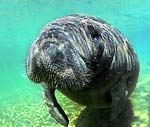 Cow
Shark Cow
SharkThe cow shark (Notorynchus cepedianus), also known as the broadnose sevengill shark, the broad snout shark, the ground shark, and the spotted sevengill shark ,is a distinctive and rare shark that has seven gills (most sharks have five). This unusual shark also has a single (and small) dorsal fin. The broadnose sevengill grows to be up to 10 ft (3 m) long, is speckled and silvery; this shark has small eyes, and a wide head. These aggressive sharks eat fish (including other sharks, rays, and bony fish), seals, and scavenged prey (including human corpses). Broadnose sevengill sharks live in temperate seas on continental shelves (to a depth of 450 ft (135 m). The upper teeth are jagged and multi-cusped (except the center tooth). The lower teeth are comb-shaped. These sharks bear live young in shallow bays. Litters of up to 80 pups have been found. Pups are about 16-18 inches (40-45 cm) long. It was named by Peron in 1807. Classification: Order Hexanchiformes, Family Hexanchidae Cretodus Cretodus is an extinct genus of Mackerel sharks that lived during the late Cretaceous period. This shark is known only from fossilized teeth and vertebrae that have been found in Africa, Europe, and North America. The length of the teeth (from the tip of the crown to the tip of the root) is about 1 1/2 inches (4 cm). Cretodus was named by Sokolov in 1965. Classification: Order Lamniformes, Family Cretoxyrhinidae. 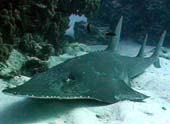 Crocodile
Shark Crocodile
SharkPseudocarcharias kamoharai is a widespread bottom-dwelling Lamniformes (or mackerel shark). This shark has a stream-lined body, gray to brown in color, with a lighter-colored belly and white edges on the fins. The eyes are very large and the head is long. The teeth are long and thin; it preys upon squid, shrimp, and fish. This common shark is harmless to man. The crocodile shark's liver is very oily, containing squalene, a low-density oil, which gives this shark neutral buoyancy. Makes average 3.1 ft (96 cm) long; females average 3 ft (92 cm) long. The biggest-known crocodile shark was 3.6 ft (1.1 m) long. Crocodile sharks reproduce via aplacental viviparity bearing four pups per litter; unborn pups are cannibalistic in each of the two womb. The eggs hatch within the female and are nourished by eating unfertilized eggs and smaller siblings in the womb. |
|||||
| Sitemap | Reach To Us | Jimtrade - Business Directory of India | |||||